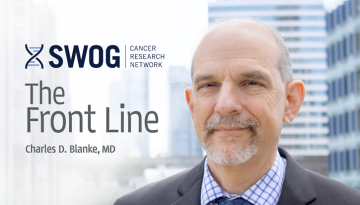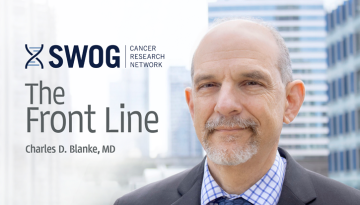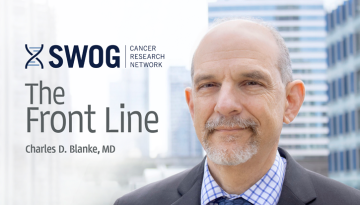S1826 Trial: Monday Morning Practice Change
All Front Lines are a pleasure to write, but this one really brought me joy. SWOG had an amazing ASCO in 2023!
Our members delivered five oral presentations – including work from trials S1011 in GU, S1609 in rare cancers, S1714 in symptom management, and S1929 in lung – and presented a record number of SWOG posters. The links will take you to our press releases on these oral presentations, and you can check out all the abstracts themselves from the links here.
But today I want to focus on the fifth oral presentation of SWOG work – results delivered at the plenary session on Sunday. It’s one of those “likely to start changing practice in the clinic on Monday” pieces of work.
The S1826 trial is a triumph in all sorts of ways, and I could not be prouder of the cross-group team that designed the trial, with leadership from Drs. Jonathan Friedberg and Alex Herrera, with their colleagues at the Children’s Oncology Group (COG), and at our other sister groups in the U.S. and in Canada.
The randomized phase III trial compared nivolumab plus the AVD combination (doxorubicin/Adriamycin, vinblastine, and dacarbazine) to a current standard treatment of brentuximab vedotin plus AVD.
Earlier this year, and to be honest, surprisingly, after the pre-planned second interim analysis of S1826, the SWOG Data and Safety Monitoring Committee recommended that the trial’s primary results be reported, because the primary endpoint – progression-free survival (PFS) – had already crossed the conservative statistical boundary that had been specified in the protocol.
The results truly were early, unexpected, and undoubtedly exciting. We reached out to the American Society for Clinical Oncology (ASCO) about submitting the results for consideration for ASCO’s annual meeting in June – this was very last minute – and the program committee quickly recognized that in addition to the impressive early PFS numbers, the trial results were potentially important in multiple ways. They actually accepted the abstract not just for presentation, but for presentation at the meeting’s plenary session.
S1826 study chair Dr. Alex Herrera did a masterful job of presenting the trial results on Sunday – and on Saturday in the pre-plenary press briefing (not to mention in numerous subsequent interviews with oncology publications such as this and this).
Granted, the trial provided Dr. Herrera a litany of great talking points beyond the progression-free survival headline, but I'll start with that:
- The nivolumab plus AVD (N-AVD) treatment cut patients’ risk of progression or death in half compared to the control arm treatment (hazard ratio of 0.48), although we need to keep in mind that the follow-up period thus far is fairly brief
- The data showed 1-year PFS of 94 percent on the nivolumab arm versus 86 percent on the brentuximab vedotin arm
- Overall, patients tolerated the N-AVD treatment better than the BV-AVD. One example: the rate of peripheral neuropathy was lower on the investigative arm – 29 percent versus 55 percent (particularly important improvement given the large number of adolescents and young adults on the trial)
- In the typical Hodgkin treatment regimen, most pediatric patients receive radiation therapy after their chemotherapy. In S1826, less than 1 percent of patients needed subsequent radiation therapy. This is especially significant for the youngest, most vulnerable patients, as it is expected to help reduce late toxic effects from therapy, effects which can manifest decades later.
The results data above, however, tell only part of the story. We need to look beyond the outcomes to the nature of the trial, how it came together, and what it accomplished in addition to amazing outcomes (remembering that these are still early days).
- It was the largest Hodgkin lymphoma trial ever conducted by the National Clinical Trials Network (NCTN)
- The study completed patient accrual – just shy of 1,000 patients – well ahead of schedule
- Patients enrolled to the study were a highly representative group:
- one-quarter were younger than 18
- 10 percent were older than 60
- one-quarter were Black or Hispanic
- higher-risk clinical subgroups were well represented
- These achievements can all be credited to the unprecedented collaboration that produced the study. S1826 represents the first time the adult NCTN groups and the COG collaborated to design and conduct such a large and successful joint pediatric/adult trial.
- Stepping back to look at the big picture, these results are a major step in potentially harmonizing what have been quite distinct treatment regimens between pediatric and adult patients in this disease
When I took office as SWOG group chair I promised we would work more closely with our COG colleagues and others in the adolescent and young adult cancer research community. S1826 and its impact are the realization of that goal.
This landmark collaboration has spawned numerous subsequent collaborations between the adult groups and the COG in this disease area, including several actively enrolling (or soon-to-be) cross-group trials:
- AHOD2131, evaluating PET-adapted use of nivolumab and brentuximab vedotin in Hodgkin lymphoma
- EA4211, incorporating pembrolizumab in therapy for patients with relapsed or refractory Hodgkin lymphoma
- ANHL1931, testing nivolumab in front-line therapy for primary mediastinal B-cell lymphoma
What’s more, a working group is now designing the advanced-stage Hodgkin lymphoma follow-up to this S1826 trial.
Although the plenary presentation on Sunday reported S1826’s primary results (endpoint reached), much more is still to come from the S1826 trial, including
- longer-term progression-free survival statistics that will tell us how durable patient responses are
- overall survival results
- patient-reported outcomes that will give us essential details about how patients are experiencing these two regimens
- future correlative studies of banked specimens and PET-CT images from this trial
I’m thrilled we’ve been able to report such a rich set of widely positive results from this trial. Even keeping in mind that these are still early results, it’s hard not to conclude that we’ve gotten to witness that rare Sunday plenary that turns right over into Monday morning practice change. I also want to give a shout out to Dr. Eric Winer, ASCO’s last president, who pointed out half the trials on the plenary podium were federally funded. Dr. Joe Unger’s recent work pointed out NCTN studies are a bargain. And S1826 gave us more than we originally bargained for – in a good way!
Other Recent Stories



